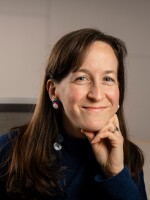One of Fresno State’s newest additions is a broad, brown, mulchy patch of land in front of the Science II building. Gardening specialist Fortunato Garcia leads volunteers with shovels to a lumpy mound.
Garcia: All right, so we'll put one fertilizer tab here, one here, one here, one there...
Before long, this patch will be more than mulch—it’s the start of a waterwise demonstration garden. Grounds supervisor Michael Frick points out the low-water bulbs and saplings that are being planted.
Frick: Right here is a bunch of sage. On the other stuff we have manzanita, native asters, penstemons; we even have a couple Palo Verde trees which are big out in the desert.
The garden is a growing, living symbol of a campus-wide collaboration to make Fresno State more sustainable.
Depending on who you ask, Fresno State may not have a reputation for water conservation. But that doesn’t mean it’s not happening. Thomas Gaffery is the Facilities Operations Manager at Fresno State. He says they’ve been tackling water conservation for years. They’ve installed electronic water mains that reduce leaks. They’ve cut down the water used for air conditioning. Plus:
Gaffery: We’ve transitioned our sprinkler heads from older outdated models that use up to 13 gallons per minute to newer models, some which use as little as 5 gallons per minute.
And then there’s the Center for Irrigation Technology, a lab that’s been advancing irrigation practices for decades. Some of their products are used on campus.
Gaffery: One of the ongoing initiatives is using a product called Aqua Cents, which actually injects organic hydrogels below the turf and helps retain water so that less water is used to irrigate the lawns.
In April, Fresno State unveiled a plan to reduce water use by 20% in a year. But announcements like this are few and far between. So it’s no surprise that the rest of campus, and the community, isn’t always aware of what’s going on.

Enter the Sustainability Project, the driving force behind the waterwise demo garden. Dr. CrissWilhite is one of the project’s founders. Her specialty is applied behavior and analysis; solving problems by helping people change their behaviors for the better. When she first got involved in sustainability on campus, she was surprised by what she found.
Wilhite: Once we got into looking at it, what we found is there is a lot more going on here than anybody knew about. The reason it wasn’t known about is that people who’re doing this are busy.
So her work has focused not just on individual changes, but campus-wide changes that can help the administration achieve their goals. A few years ago, one of her classes made a detailed analysis of how students use campus grounds.
Wilhite: What we found is, hardly anybody was sitting in the lawn. If there were tables and benches around, people were sitting on those.
The conclusion: less grass, more seating. The demo garden will not only save water and be nice to look at, it’ll have benches. Plus, it’ll feature signs about the plants and how to take care of them.
The Sustainability Project also recruited student volunteers, so-called Sustainability Ambassadors. Back in April, Kassandra Hishida and her fellow Ambassadors helped put on a campus-wide Earth Day fair.
Hishida: We had a great mix of vendors…the San Joaquin Valley Air Pollution Control District was there…the Chaffee Zoo was there talking about their conservation efforts…there was the Fresno State Food Recovery Network…tons of other groups.
It was one of many efforts to improve the communication about sustainability. But Hishida says there are more obstacles to fixing up campus than a lack of awareness.
Hishida: The #1 challenge…was the issue of being a commuter campus. Students can drive, whether it’s 10 minutes or 2 hours, to and from school, they don’t have a lot of time between classes, work, to stay on campus late and to get involved.
Finding solutions to this problem is one long-term goal of the Sustainability Ambassadors. Challenges aside, CrissWilhite is excited about the future of water conservation and sustainability on campus.
Wilhite: We have support on both the academic and facilities side; and the students, they just eat it up. We’ve got all those levels. I’m very very hopeful and optimistic.
With the help of a few pending grants, the Sustainability Project hopes to develop two more waterwise gardens on campus.


